This species has been observed on Reunion, Mauritius, Mayotte and Seychelles Islands
Species characteristics : Mantle white with a bright orange or yellow-orange border and small purple spots all over. Each spot is surrounded by a ring of a much paler purple.
The rhinophore stalk is translucent, the club orange or yellow with a whitish tip. The gills are white translucent sometimes with a yellowish tinge |

|
|
| Showing species characteristics... | Photo Philibert Bidgrain Reunion, Etang salé on a rocky coast, 25 October 2005, size : 15 mm |
|
See more about : Sightening and mating periods
See more about : Chromodoris aspersa variability in Southwest Indian ocean
Remarks :
Identification confirmed by Bill Rudman and Nathalie Yonow
Synonymous (according worms) :
- Chromodoris inortata, Pease, 1871
- Chromodoris pallescens, Bergh, 1875
- Doris amabalis, Kelaart, 1859
- Doris aspersa, Gould, 1852
- Doris punctulifera, Bergh, 1874
- Glossodoris inortata, Pease, 1871
Bibliographic data :
Several members of the family Chromodorididae have reddish or purplish spots on the mantle, but C. aspersa is the only species to have purple spots in combination with an orange marginal band.
Color variation and local form :
- In some specimens the mantle border and the rhinophores are distinctly yellow or orange and in others both are very pale yellow.
- In some larger specimens there are purple spots on the base of the gills.
- Red Sea form : This differs in having much larger purple spots, which are slightly raised. Each spot does not have the characteristic faint purple ring although there is some diffuse purple pigment around it.
- Hawaiian Form : This form appears to be identical to typical west Pacific specimens with many small purple spots each surrounded by a watered purple ring but it differs in not having an orange or yellow border to the mantle.
The body and foot are white with small purple spots, as on the mantle. Usually there is no colour border to the foot except sometimes a trace of orange on the posterior tip, but in some larger specimens there can be a washy yellow border to the foot deepens posteriorly to the same colour as the mantle border.
The seven to up to nine, simple gills form a complete circle around the anus. They are translucent white to watery yellow orange
According to Boucher (1983) and Johnson & Boucher (1983), this species lays a pale yellow spawn mass consisting of a tight coil of six whorls. The ova (75 µm diameter) occur individually within capsules (90 µm ). Extra-capsular yolk bodies are scattered between the capsules throughout the egg string and larvae hatch as free-swimming veligers.
Like many nudibranches, they feeds on siliceous sponges (Desmospongiae)
Material examined by Nathalie Yonow ( see reference/publications).
One specimen collected from Tamarin (Mauritius), 24 October 1985, size : 15 mm.
References :
Site de Bill Rudman : Sea Slug Forum : Chromodoris aspersa
Nudipixel Chromodoris aspersa
Publications :
Boucher,L.M. 1983. Extra-capsular yolk bodies in the egg masses of some tropical Opistobranchia. Journal of Molluscan Studies 49: 232-241
Johnson, S. & Boucher, L.M. 1983. Notes on some Opistobranchia (Mollusca : Gastropoda) from the Marshall Islands , including 57 new records Pacific Sciences 37(3) : 251-291
Gould, A.A. (1852). United States Exploring Expedition during the years 1838-1842. Mollusca and Shells, 12 : 510 pp (with Atlas of Plates, 1856.
Rudman, W.B. (1983) The Chromodorididae (Opisthobranchia: Mollusca) of the Indo-West Pacific: Chromodoris splendida, C. aspersa and Hypselodoris placida colour groups. Zoological Journal of the Linnean Society, 78 : 105-173.
Yonow, N. and Hayward , P. J. (1991). Opistobranches de l'île Maurice, avec la description de deux espèces nouvelles (Mollusca : Opistobranchia) Revue française d'aquariologie herpétologie, 18 (1), 1-30
Other photos of Chromodoris aspersa :
Philibert Bidgrain Reunion, Etang salé on a rocky coast, 16 October 2005, size : 25 mm You can observe in this large specimen : Purple spots on the base of the gills. The pale "washy purple" ring around each purple spot
|
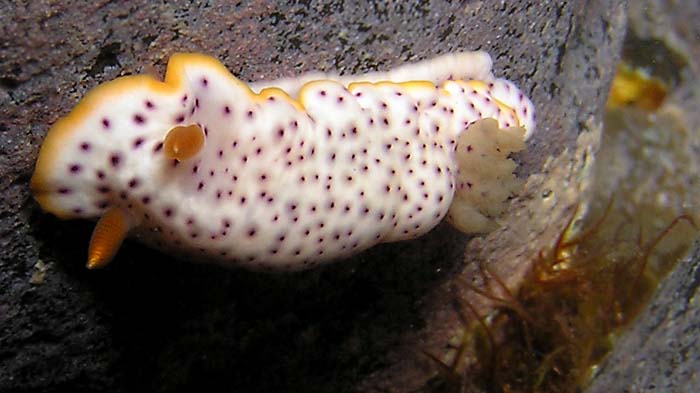 |
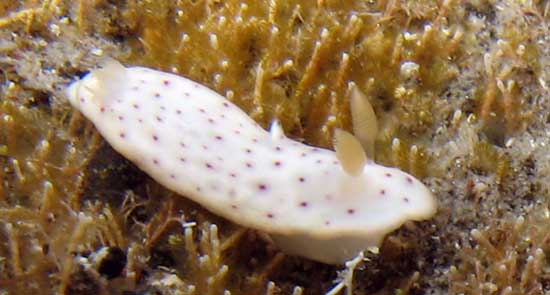 |
Philibert Bidgrain Reunion, Etang salé on a rocky coast, 05 November 2006, size : 12 mm. In this small specimen the mantle border and the rhinophores are very pale yellow. |
Philibert Bidgrain Gill details of this nudibranch. When fully extended the gills stand upright in a curved shaped arrangement | Reunion, 25 September 2004, in "'Etang Salé lagoon". Size : 20 to 30 mm.
|
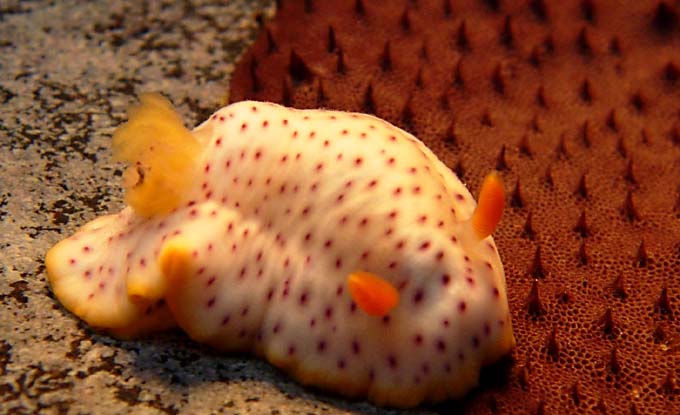 |
Christophe Cadet Reunion, Etang salé on a rocky coast, 20 September 2009, size : 25 mm. In this specimen, the gills have a yellow-orange tinge |
Maurice Jay Reunion, Many specimens found in "Grand-Fond" (shallow water lagoon), "Mare de Baramine" and "Pointe de Baramine". Thin orange-red mantle border |
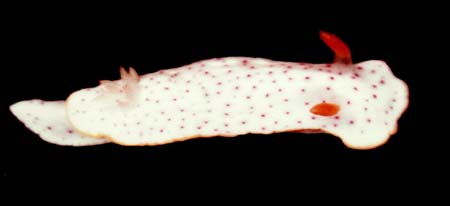 |
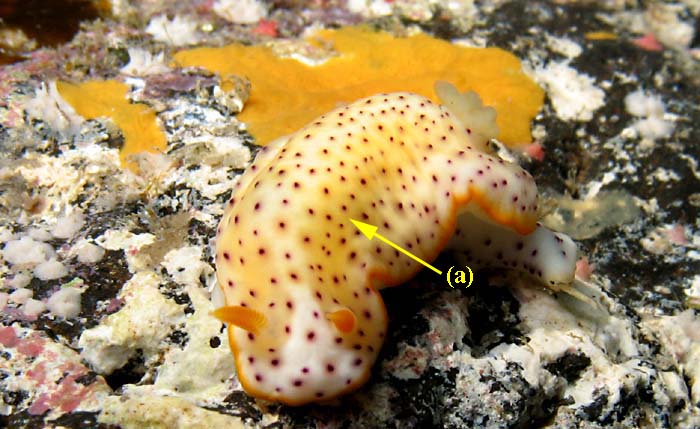 |
Philibert Bidgrain Reunion, Etang salé lagoon, less 1 m, 9 November 2010, size : 15 mm. Specimen with a diffuse pale brown-orange coloration (a) on the notum |
Christophe Cadet Reunion, Etang sale, on the rocky coast, less 1 m, 18 September 2010, size : 2-3 mm
A juvenile form... |
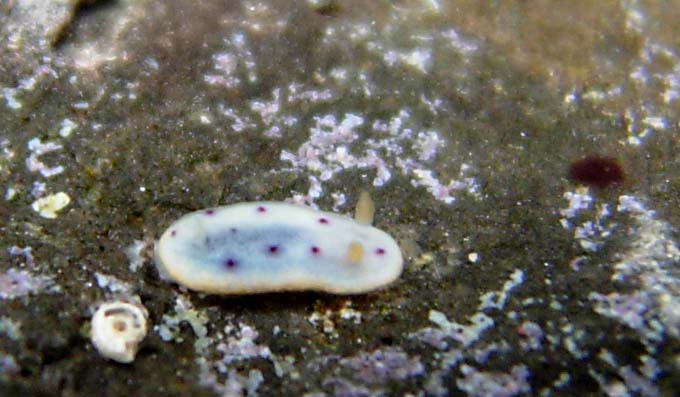 |
More photos from Indian Ocean
See more about : Chromodoris aspersa variability in Southwest Indian ocean
Reunion, C.aspersa, like an ostrich, at Etang salé, by Alain Barrére
Reunion, polychaete worm and C. aspersa, at Etang salé, by Hugues Flodrops
Reunion, C. aspersa, at Saint Gilles, by Sophie Darnis
Mauritius, drawing of a specimen of Chromodoris aspersa, from Tamarin, by Nathalie Yonow
Reunion, Chromodoris aspersa with purple spots on the gills, at Etang salé, by Christophe Cadet
Reunion, a juvenile of Chromodoris aspersa, at Etang salé, by Christophe Cadet
Reunion, a pair of Chromodoris aspersa, at Etang salé, by Philibert Bidgrain
Mayotte, a small Chromodoris aspersa, at Mstanga Tsohoa, by Norbert Verneau
Seychelles, Chromodoris aspersa, at Mahé, by Christophe Mason-Parker

